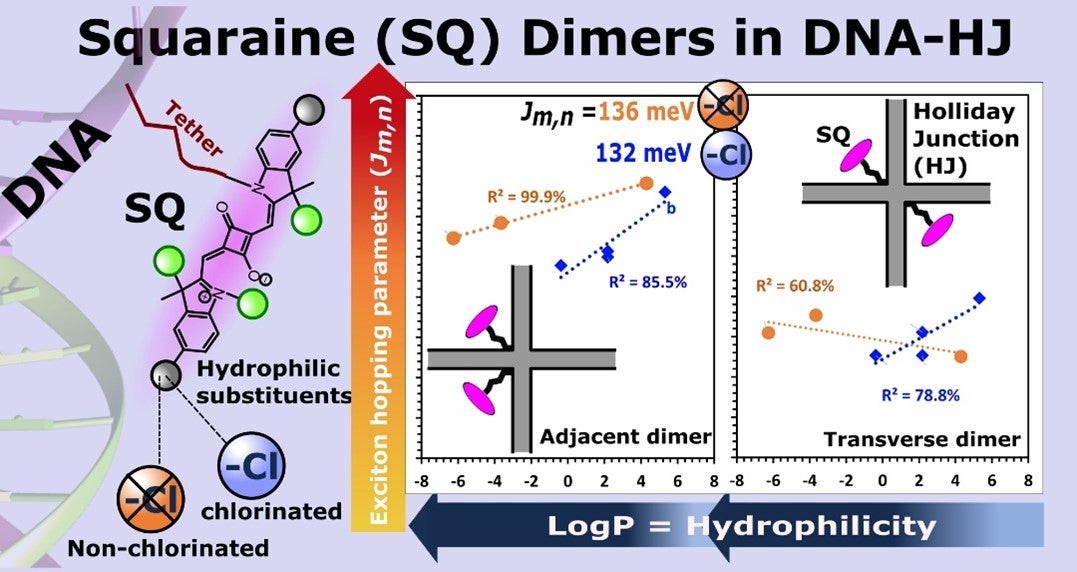Article by Postdoctoral research fellow Gissela Pascual and Research Program Manager Mandeep Sharma.

Exciton delocalization is the collective sharing of electronic excitation energy of dyes in an aggregate. Customization of squaraine dyes with hydrophilic imparting substituents enables the tunability of exciton delocalization that can be leveraged in impactful applications such as optical information processing and light harvesting
What did the Scientists/ Engineers Discover?
Researchers at Boise State University have successfully formed aggregates of hydrophilic dyes that exhibit strong exciton delocalization. These aggregates, excited by light, share a delocalized exciton across the dyes. This shows that the quasiparticle exciton made up of bound electron and hole pairs can exist between the participant dyes. Exciton delocalization is a high-efficiency energy transfer process useful for several applications to develop next-generation technologies such as room-temperature quantum computing, artificial light-harvesting systems, and organic optoelectronics.
However, the propensity of dyes to form aggregates is limited by their hydrophilic property which is the capacity of dyes to dissolve in water. Less hydrophilic dyes (or hydrophobic dyes) have shown a higher propensity to form aggregates exhibiting strong exciton delocalization driven by hydrophobic interaction. Nevertheless, forming hydrophilic dye aggregates is challenging due to the increased inter-dye distance when dyes dissolve in water.
To overcome this challenge, Dr. Gissela Pascual and colleagues from the Quantum DNA Research Group at the Micron School for Materials Science and Engineering, used a clever method. They attached photostable hydrophilic squaraine (SQ) dyes to deoxyribonucleic acid (DNA) that can be chemically modified and exhibit unique spectral properties. By using four-arm DNA Holliday junction structures (DNA HJ), composed of two DNA strands labeled with SQ and two without dye, researchers brought these dyes close enough to form aggregates and exhibit strong exciton delocalization. Interestingly, they found that increasing hydrophilicity weakened the exciton delocalization calculated using an in-house developed modeling tool. They also discovered that some dyes formed aggregates with subpopulations that exhibited differentiated exciton delocalization.
This research gives us new insights into how to make hydrophilic dye aggregates with strong exciton delocalization. This finding opens exciting possibilities for using these hydrophilic dye aggregates in quantum information systems.
Impact
Researchers led by Pascual found that certain hydrophilic SQ dyes templated by DNA-HJ can share energy in a process called coherent exciton delocalization. This energy sharing can help bridge the gap between existing technology and the development of molecular quantum materials.
Study Investigators
- Gissela Pascual – MSMSE, Boise State University
- Simon K. Roy − MSMSE, Boise State University
- German Barcenas − MSMSE, Boise State University
- Christopher K. Wilson − MSMSE, Boise State University
- Keitel Cervantes-Salguero − MSMSE, Boise State University
- Olena M. Obukhova – State Scientific Institution “Institute for Single Crystals” of the National Academy of Sciences of Ukraine
- Alexander I. Krivoshey – State Scientific Institution “Institute for Single Crystals” of the National Academy of Sciences of Ukraine
- A. Terpetschnig − SETA BioMedicals, LLC
- Anatoliy L. Tatarets−State Scientific Institution “Institute for Single Crystals” of the National Academy of Sciences of Ukraine
- Lan Li − MSMSE, Boise State University
- Bernard Yurke – MSMSE and Department of Electrical & Computer Engineering (ECE), Boise State University
- William B. Knowlton − MSMSE and ECE, Boise State University
- Olga A. Mass − MSMSE, Boise State University
- D. Pensack− MSMSE, Boise State University
- Jeunghoon Lee – MSMSE and Department of Chemistry and Biochemistry, Boise State University
Publication Citation
Gissela Pascual, Simon K. Roy, German Barcenas, Christopher K. Wilson, Keitel Cervantes-Salguero, Olena M. Obukhova, Alexander I. Krivoshey, Ewald A. Terpetschnig, Anatoliy L. Tatarets, Lan Li, Bernard Yurke, William B. Knowlton, Olga A. Mass, Ryan D. Pensack and Jeunghoon Lee. Effect of hydrophilicity-imparting substituents on exciton delocalization in squaraine dye aggregates covalently templated to DNA Holliday junctions. Nanoscale 2024, 16, 1206-1222. https://doi.org/10.1039/D3NR04499H
Funding
| Funding Agency | Grant/Contract Number | Role of Funding |
|---|---|---|
| U.S. Department of Energy (DOE), Office of Basic Energy Sciences, Materials Sciences and Engineering Division and DOE’s Established Program to Stimulate Competitive Research (EPSCoR) | DOE award DE-SC0020089 | Primary funding for Pascual et al. 2021 |
Disclaimer
Any opinions, findings, conclusions, or recommendations expressed in this material are those of the authors and do not necessarily reflect the views of the DOE.